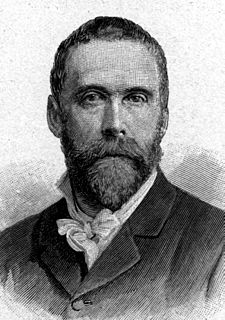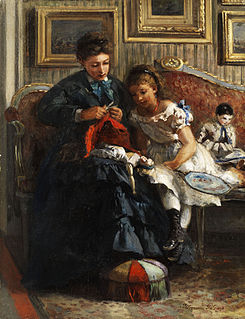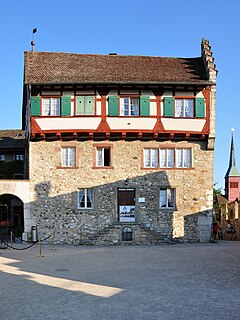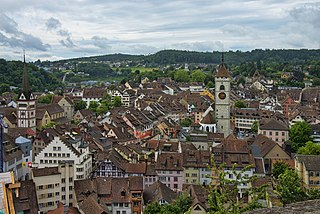
The Rhine Falls is the largest waterfall in Switzerland and Europe.

Anton Graff was an eminent Swiss portrait artist. Among his famous subjects were Friedrich Schiller, Christoph Willibald Gluck, Heinrich von Kleist, Frederick the Great, Friederike Sophie Seyler, Johann Gottfried Herder, Gotthold Ephraim Lessing, Moses Mendelssohn and Christian Felix Weisse. His pupils included Emma Körner, Philipp Otto Runge and Karl Ludwig Kaaz.

Elias Gottlob Haussmann was a German painter in the late Baroque era. Haussmann served as court painter at Dresden, and from 1720 as the official portraitist at Leipzig. He is mostly known for his portrait of Johann Sebastian Bach which was painted in 1746.

Ludwig von Hofmann was a German painter, graphic artist and designer. He worked in a combination of the Art Nouveau and Symbolist styles.
Jan Joost van Cossiau (c.1660–1732) was a Flemish landscape painter and engraver who was born near Breda. He spent most of his career in Frankfurt am Main. His landscapes usually include people, and also often buildings and cattle. They are in the “Italian style” and generally resemble those of Gaspard Dughet (1613–1675). Cossiau worked for Lothar Franz von Schönborn at his electoral court, as well as at his Schloss Weißenstein (castle). He was also director of the electoral gallery at Pommersfelden, where he established the final directory of paintings, after the first survey by Johann Rudolph Bys. In order to extend his gallery, Lothar Franz sent his two gallery directors often to the Netherlands and Italy. Jan Joost van Cossiau died in Mainz in 1732.

Gaudenz Taverna was a Swiss portrait painter and graphic artist.

Bernhard Studer was a Swiss landscape painter.

Christian Ernst Bernhard Morgenstern was a German landscape painter. Morgenstern is regarded as one of the pioneers in Germany of early Realism in painting. He gained this reputation in Hamburg 1826-1829 together with his contemporary Adolph Friedrich Vollmer while both were still studying; from 1830 onwards, Morgenstern, together with Friedrich Wasmann, Johan Christian Dahl and Adolph Menzel, introduced Munich to Realist painting.

Gabriel (von) Hackl was a German historicist painter.

Johann Jakob Schalch was a Swiss painter. He was a contemporary of the Swiss painters Anton Graff, Jean Preudhomme, Angelica Kauffman, Jakob Emanuel Handmann, Johann Caspar Füssli. His son Johann Heinrich Füssli was also a noted painter.

Louis Sussmann-Hellborn, also spelled Ludwig Sussman Hellborn, was a German sculptor, painter, art collector and contractor.

Syrius Eberle was a German sculptor and art professor.

Ludwig Ferdinand Schnorr von Carolsfeld was a German Romantic painter, engraver and lithographer.

Johann Gottlieb Hantzsch was a German genre painter.

Hans Larwin was a Viennese genre painter and academician.

Pietronella Peters was a German painter who specialized in portraits and genre scenes of children.
Johann Koerbecke was a German Gothic painter of the Westphalian School. He is believed to have worked with the Master of the Schöppingen Altarpiece and the Master of 1473. He was the first painter from Westphalia who can be named.























